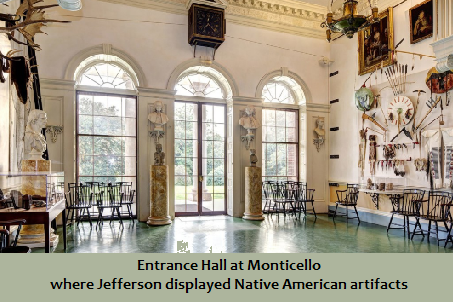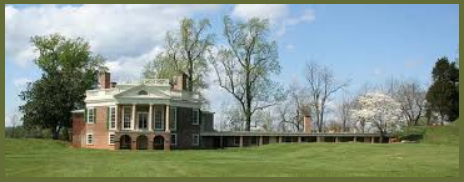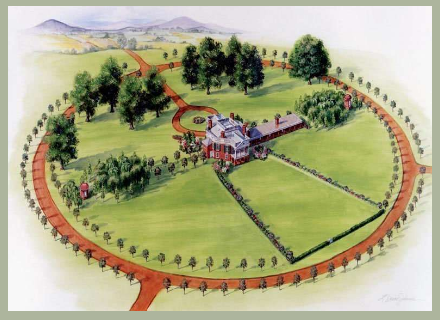Essays Contents
Jefferson
July 3, 2023
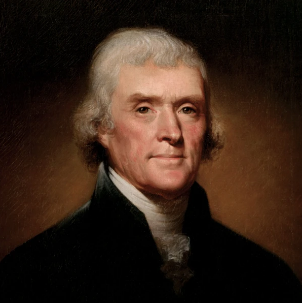
Thomas Jefferson
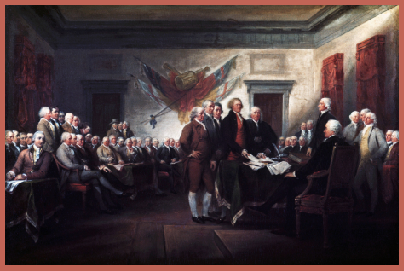
56 delegates signed the Declaration of Independence
Thomas Jefferson composed it.
from the Whitehouse bio page
"In the thick of party conflict in 1800, Thomas Jefferson wrote in a
private letter, “I have sworn upon the altar of God eternal hostility
against every form of tyranny over the mind of man.”
"This powerful advocate of liberty was born in 1743 in Albemarle County,
Virginia, inheriting from his father, a planter and surveyor, some
5,000 acres of land, and from his mother, a Randolph, high social
standing. He studied at the College of William and Mary, then read law.
In 1772 he married Martha Wayles Skelton, a widow, and took her to
live in his partly constructed mountaintop home, Monticello.
"Freckled and sandy-haired, rather tall and awkward, Jefferson was
eloquent as a correspondent, but he was no public speaker. In the
Virginia House of Burgesses and the Continental Congress, he contributed
his pen rather than his voice to the patriot cause. As the “silent member”
of the Congress, Jefferson, at 33, drafted the Declaration of Independence.
In years following he labored to make its words a reality in Virginia.
Most notably, he wrote a bill establishing religious freedom, enacted in 1786.
"Jefferson succeeded Benjamin Franklin as minister to France in 1785. His sympathy for the French Revolution led him into conflict with Alexander Hamilton when Jefferson was Secretary of State in President Washington’s Cabinet. He resigned in 1793.
"Sharp political conflict developed, and two separate parties, the Federalists
and the Democratic-Republicans, began to form. Jefferson gradually assumed
leadership of the Republicans, who sympathized with the revolutionary cause
in France. Attacking Federalist policies, he opposed a strong centralized
Government and championed the rights of states.
"As a reluctant candidate for President in 1796, Jefferson came within three
votes of election. Through a flaw in the Constitution, he became Vice President,
although an opponent of President Adams. In 1800 the defect caused a more
serious problem. Republican electors, attempting to name both a President
and a Vice President from their own party, cast a tie vote between Jefferson
and Aaron Burr. The House of Representatives settled the tie. Hamilton,
disliking both Jefferson and Burr, nevertheless urged Jefferson’s
election.
"When Jefferson assumed the Presidency, the crisis in France had passed.
He slashed Army and Navy expenditures, cut the budget, eliminated the
tax on whiskey so unpopular in the West, yet reduced the national debt by
a third. He also sent a naval squadron to fight the Barbary pirates, who
were harassing American commerce in the Mediterranean. Further,
although the Constitution made no provision for the acquisition of new
land, Jefferson suppressed his qualms over constitutionality when he had
the opportunity to acquire the Louisiana Territory from Napoleon in
1803.
"During Jefferson’s second term, he was increasingly preoccupied with
keeping the Nation from involvement in the Napoleonic wars, though both
England and France interfered with the neutral rights of American
merchantmen. Jefferson’s attempted solution, an embargo upon American
shipping, worked badly and was unpopular.
"Jefferson retired to Monticello to ponder such projects as his grand designs
for the University of Virginia. A French nobleman observed that he had
placed his house and his mind “on an elevated situation, from which he
might contemplate the universe.”
He died on July 4, 1826."
Thomas Jefferson (April 13, 1743 – July 4, 1826) was an American statesman,
diplomat, lawyer, architect, philosopher, and Founding Father who served
as the third president of the United States from 1801 to 1809. Among the
Committee of Five charged by the Second Continental Congress with
authoring the Declaration of Independence, Jefferson was the document's
primary author.
Following the American Revolutionary War and prior to becoming president
in 1801, Jefferson was the first U.S. Secretary of State under George
Washington and then the nation's second vice president under John Adams.
Jefferson's writings and advocacy for human rights, including freedom of
thought, speech, and religion, helped inspire the American Revolution,
which ultimately led the American Revolutionary War in which Patriots
defeated the British, leading to American independence, the United States Constitution, and the establishment of the United States as a free and
sovereign nation.
He was a leading proponent of democracy, republicanism, and individual
rights, and produced formative documents and decisions at the state,
national, and international levels. During the American Revolution, Jefferson
represented Virginia at the Second Continental Congress in Philadelphia,
which adopted the Declaration of Independence on July 4, 1776, and
served as the second Governor of Virginia from 1779 to 1781.
In 1785, Congress appointed Jefferson United States Minister to France,
where he served from 1785 to 1789. President Washington then appointed
Jefferson the nation's first secretary of state, where he served from
1790 to 1793. During this time, in the early 1790s, Jefferson and James
Madison organized the Democratic-Republican Party to oppose the
Federalist Party during the formation of the nation's First Party System.
With Madison, Jefferson anonymously wrote the Kentucky and Virginia
Resolutions in 1798 and 1799, which sought to strengthen states' rights by
nullifying the federal Alien and Sedition Acts.
"Monticello (MON-tih-CHEL-oh) was the primary plantation of Thomas
Jefferson, a Founding Father and the third president of the United States,
who began designing Monticello after inheriting land from his father at
age 14. Located just outside Charlottesville, Virginia, in the Piedmont
region, the plantation was originally 5,000 acres (20 km2), with Jefferson
using the labor of African slaves for extensive cultivation of tobacco and
mixed crops, later shifting from tobacco cultivation to wheat in response
to changing markets.
"Due to its architectural and historic significance, the property has been
designated a National Historic Landmark. In 1987, Monticello and the
nearby University of Virginia, also designed by Jefferson, were together
designated a UNESCO World Heritage Site. The current nickel, a United
States coin, features a depiction of Monticello on its reverse side.
"Jefferson's home was built to serve as a plantation house, which ultimately
took on the architectural form of a villa. It has many architectural antecedents,
but Jefferson went beyond them to create something very much his own.
He consciously sought to create a new architecture for a new nation.
video: how Monticello was built
monticello.org - tour of rooms, use side panel
video here of the operation of the double-sash arched windows
Jefferson's other home that no one ever mentions...
Poplar Forest.
"Poplar Forest is a plantation and plantation house in Forest, Bedford
County, Virginia. Founding Father and third U.S. president Thomas
Jefferson designed the plantation, and used the property as both a private
retreat and a revenue-generating plantation. Jefferson inherited the
property in 1773 and began designing and working on the plantation
in 1806. While Jefferson is the most famous individual associated with the
property, it had several owners before being purchased for restoration,
preservation, and exhibition in 1984."
Poplar Forest.org website
YouTube channel for Poplar Forest
Book lecture: "Poplar Forest" Travis McDonald
TRAVIS MCDONALD: POPLAR FOREST:
THE LOST PRIVATE WORLD OF THOMAS JEFFERSON
05.01.23 Book lecture:
Poplar Forest,
Recovering the lost private world of Thomas Jefferson
by the head architect of the restoration of Poplar Forest,
(he says this is his last lecture, so he's covering everything)
Join Travis McDonald, Director of Architectural Restoration at Poplar
Forest, who will discuss what the award-winning restoration of
the plantation has revealed about Jefferson’s characteristics as an
accomplished architect and builder.
monticello.org - tour of rooms, use side panel
video here of the operation of the double-sash arched windows
Jefferson's other home that no one ever mentions...
Poplar Forest.
YouTube channel for Poplar Forest
Book lecture: "Poplar Forest" Travis McDonald

